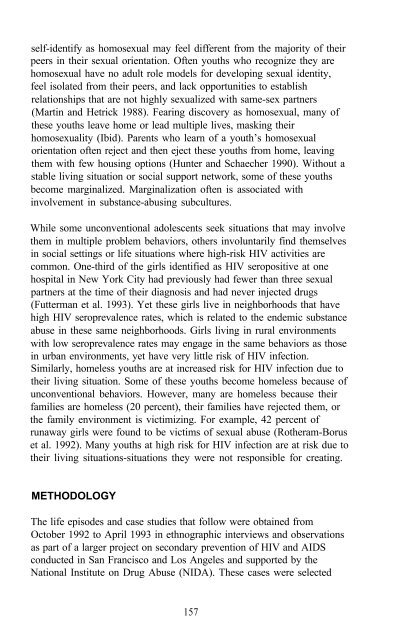The Context of HIV Risk Among Drug Users and Their Sexual Partners
The Context of HIV Risk Among Drug Users and Their Sexual Partners
The Context of HIV Risk Among Drug Users and Their Sexual Partners
Create successful ePaper yourself
Turn your PDF publications into a flip-book with our unique Google optimized e-Paper software.
self-identify as homosexual may feel different from the majority <strong>of</strong> their<br />
peers in their sexual orientation. Often youths who recognize they are<br />
homosexual have no adult role models for developing sexual identity,<br />
feel isolated from their peers, <strong>and</strong> lack opportunities to establish<br />
relationships that are not highly sexualized with same-sex partners<br />
(Martin <strong>and</strong> Hetrick 1988). Fearing discovery as homosexual, many <strong>of</strong><br />
these youths leave home or lead multiple lives, masking their<br />
homosexuality (Ibid). Parents who learn <strong>of</strong> a youth’s homosexual<br />
orientation <strong>of</strong>ten reject <strong>and</strong> then eject these youths from home, leaving<br />
them with few housing options (Hunter <strong>and</strong> Schaecher 1990). Without a<br />
stable living situation or social support network, some <strong>of</strong> these youths<br />
become marginalized. Marginalization <strong>of</strong>ten is associated with<br />
involvement in substance-abusing subcultures.<br />
While some unconventional adolescents seek situations that may involve<br />
them in multiple problem behaviors, others involuntarily find themselves<br />
in social settings or life situations where high-risk <strong>HIV</strong> activities are<br />
common. One-third <strong>of</strong> the girls identified as <strong>HIV</strong> seropositive at one<br />
hospital in New York City had previously had fewer than three sexual<br />
partners at the time <strong>of</strong> their diagnosis <strong>and</strong> had never injected drugs<br />
(Futterman et al. 1993). Yet these girls live in neighborhoods that have<br />
high <strong>HIV</strong> seroprevalence rates, which is related to the endemic substance<br />
abuse in these same neighborhoods. Girls living in rural environments<br />
with low seroprevalence rates may engage in the same behaviors as those<br />
in urban environments, yet have very little risk <strong>of</strong> <strong>HIV</strong> infection.<br />
Similarly, homeless youths are at increased risk for <strong>HIV</strong> infection due to<br />
their living situation. Some <strong>of</strong> these youths become homeless because <strong>of</strong><br />
unconventional behaviors. However, many are homeless because their<br />
families are homeless (20 percent), their families have rejected them, or<br />
the family environment is victimizing. For example, 42 percent <strong>of</strong><br />
runaway girls were found to be victims <strong>of</strong> sexual abuse (Rotheram-Borus<br />
et al. 1992). Many youths at high risk for <strong>HIV</strong> infection are at risk due to<br />
their living situations-situations they were not responsible for creating.<br />
METHODOLOGY<br />
<strong>The</strong> life episodes <strong>and</strong> case studies that follow were obtained from<br />
October 1992 to April 1993 in ethnographic interviews <strong>and</strong> observations<br />
as part <strong>of</strong> a larger project on secondary prevention <strong>of</strong> <strong>HIV</strong> <strong>and</strong> AIDS<br />
conducted in San Francisco <strong>and</strong> Los Angeles <strong>and</strong> supported by the<br />
National Institute on <strong>Drug</strong> Abuse (NIDA). <strong>The</strong>se cases were selected<br />
157
















